Every morning between 5.45 and 7.45, about 10,000 people travel through Dublin Airport. At 6.45am on a Friday I encounter seven of them, a hen party from Finglas who are on their way to Benidorm.
Elaine Dempsey, dressed all in white with a plastic tiara, is the bride. Her mother, Lizzie, is wearing deely-boppers and sunglasses with frames shaped like cocktail glasses.
“What happens in Benidorm stays in Benidorm,” she says darkly.
0 of 16
“You should get a photo when we come back, for the before and after,” says Josey Dunne, Dempsey’s aunt, who is wearing a feather boa.
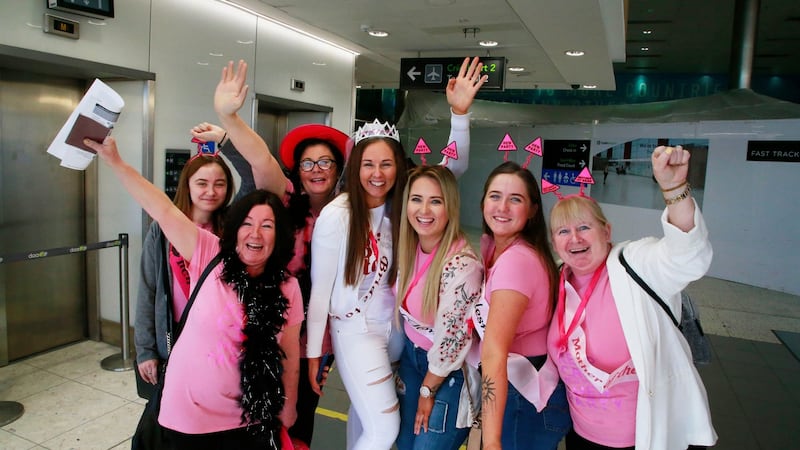
“It’ll be like that film ‘The Hangover’,” says Sandra Flynn, a friend and neighbour in a pink cowboy hat.
“He looks like the fella from ‘The Hangover’,” says Lizzie pointing at me.
“Thank you?” I say.
“He should come along,” says Dunne.
“Do you want me to put you in my bag?” asks Flynn. Then one of them says something I can’t repeat, and the younger women look shocked.
“They’ll be the worst,” says Dempsey of her older relatives and friends.
“It’s true,” says Flynn. “We will.”
Origins
Dublin Airport is situated where it is because in 1917 an RAF pilot called Sholto Douglas crashed his plane into a plough horse in France. Sent to recuperate in Ireland, he was later considered to have enough local knowledge to scout for Irish air strip locations.
In the 1930s when a proposed civilian airport was under discussion, the sites suggested included Tallaght, the Phoenix Park, a site near Poolbeg in Sandymount and an airstrip in north Dublin that Douglas had selected.

I learn all this from Dublin Airport Authority’s chief communications officer, Paul O’Kane, in the award-winning terminal designed by Desmond Fitzgerald and built between 1938 and 1940. It opened to little fanfare because the government feared publicising its location during the war. (One of the old hangars had the word “Eire” painted on the roof lest any German pilot mistook it for a British airport.)
This building, which is a protected structure and which you can see when using the curved “sky bridge” running from Terminal 1 to Pier D, became more of a back-office after Terminal 1 opened in 1972. Like other airports of the time, it was built to resemble the transportation of an earlier age, a cruise ship, and it was curved so that it had more surface area for planes to “dock”.
“It’s like it’s hugging you,” says O’Kane.
We walk from the beautiful entry hall, once stocked with shops, and up the stairs as O’Kane discusses the holistically designed fittings. There was a special vacuum system that sucked all the dirt into a tank in the basement and there were vacuum tubes for sending messages around the building.
He laments the fact that in some ways the building was designed to be looked at, not worked in, so that some rooms are blessed with huge windows and others have little natural light. We reach the old air traffic control tower on the roof, where Met Éireann has an office.
“If you’ve bet on it being a white Christmas, it must snow here,” he says.
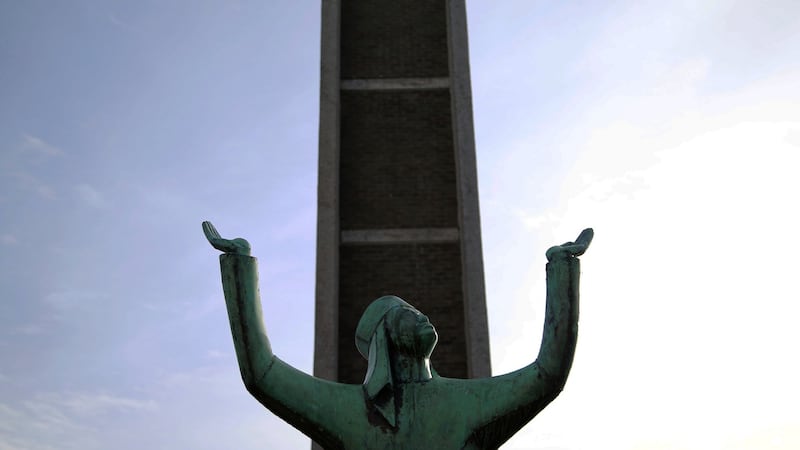
We descend again. In the 1950s and 1960s, when few travelled by plane, the airport was a very glamorous place. The well to-do had wedding brunches here. There were dinner dances and the restaurant, The Collar of Gold, was frequented by luminaries such as Charles Haughey. We stop at a photo of well-heeled diners and bow-tied waiters. O’Kane points at a nun in the centre. “There was always a nun,” he says.
Downstairs he tells me about a Pathe News film created here in 1939. “The subtext is ‘Plucky Little Eire is Building an Airport’.” He laughs. “There was so much optimism. Did they know the war was about the start?”
All Ireland Sunday
“This is a security announcement. Keep your baggage with you at all times. Unattended baggage will be removed and may be destroyed.”
“That’s my voice,” says Siobhán O’Donnell, head of external communications with the DAA. “I hear it all day.” She talks about everything that’s involved in getting people through the airport. “We have an average of 80,000 people here each day and it peaks at over 100,000. That’s like Croke Park on an All Ireland Sunday.”
Dublin Airport is a category 9 airport, but it also features the biggest bus terminal, the biggest lost and found office and the biggest taxi rank in the country. “It’s a city that happens to have an airport in it,” she says.
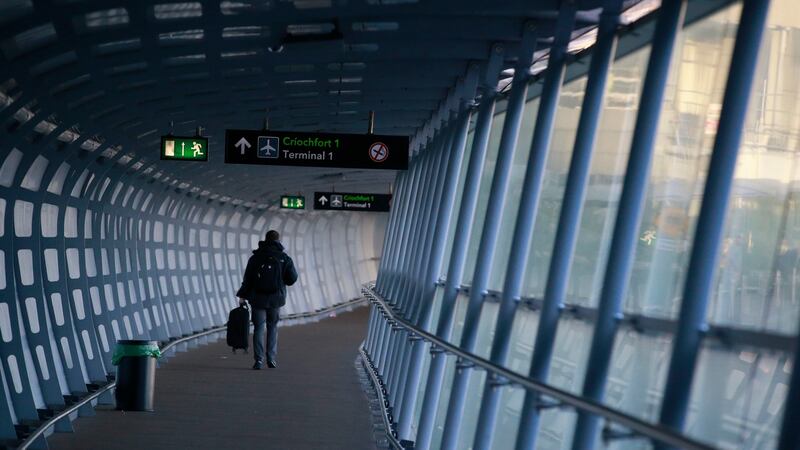
In 2010 Terminal 2 opened inauspiciously during the same week that the Troika came to Ireland. They had experienced a fall in numbers. “But this has been our eighth year of consecutive growth,” says O’Donnell. “We have 190 destinations in over 40 countries. When I started in 1984 we had 2.5 million passengers a year. We now get that in a month.”
In those days, she says, most travellers were not going on holidays or business trips but were emigrating. “There was a place [in Departures] we nicknamed the ‘wailing wall’ because it was so upsetting.”
Building work
Currently there’s a lot of building work due to a runway resurfacing operation and a new runway will begin construction later in the year. “The airport is a sort of barometer of how the country is doing,” says O’Donnell.
At around 7am, Paris Georgia, Alicia Alba and Abi Phillips, members of a Birmingham-based country band called the Adelaides, are queuing for a flight to England. They look like a band. They’re meticulously dressed and holding guitars. Alba is wearing a cowboy hat.
Do they have any tips for less-seasoned travellers? “Coffee, coffee, coffee,” says Georgia.
“Eye drops,” says Phillips. “And concealer for girls.” She pauses. “And for boys.”
Downstairs in arrivals, two sleepy young women are sitting either side of some pink helium-filled balloons procured from “Mister Price” in Nenagh. “I am,” says Tara Guest, “a professional waver-offer and welcome-homer.”
A few moments later they’re embracing their friend Anna McCluskey who’s just returned from a job in Sydney “waving traffic with those big lollypop things. The visa was up. It was meant to be a surprise for everyone but you can’t keep anything secret now.”
But is she happy to be home? “I’m beyond glad,” she says, beaming.
What now? “I’m going to eat Irish food, a big dirty f**king fry. And Silk Cut Choice,” she adds. “I want to smoke a Silk Cut Choice.”
They don’t have those in Sydney? “No,” she says. “They do not. I’m telling you it’s the little things you miss.”
Dead birds
Out in the fire station, beyond where Denis O’Brien keeps his private jet, Ricky Whelan has a freezer full of dead birds. Whelan is one of two consultant ornithologists who work at the airport assessing bird behaviour.
Any dead bird found onsite needs to be identified and its cause of death ascertained in case it was killed by a plane. Unidentified species are sent to UCC for DNA testing (they have a near 100 per cent identification record). It’s like a bird CSI.
“This is a black headed gull,” says Whelan. “The neck is broken. All internal organs have detached from the muscles around it. And that’s how we can tell it’s a bird strike.”
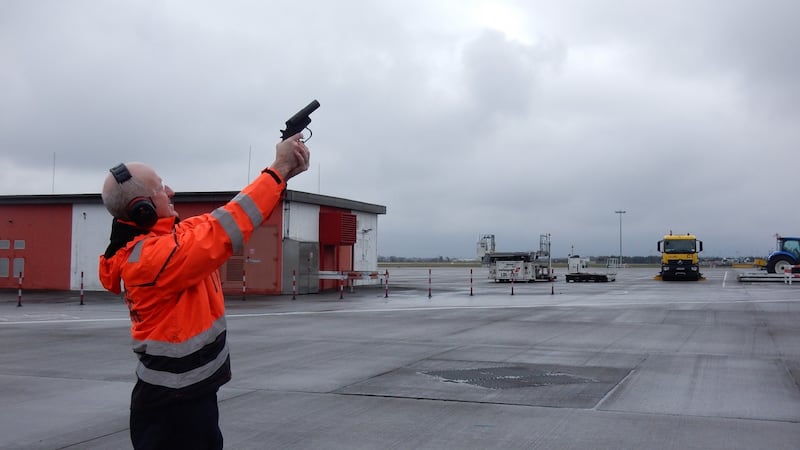
I came here partly to learn about the airport’s 100-strong team of fire fighters and their unusually large water-carrying fire trucks. And, yes, chief fire officer Gerry Keogh tells me all about “full emergencies” (most turn out okay) and “local standbys” when incoming planes have technical issues (there are 50 or 60 of these a year) and his team’s below three-minute response time.
But then he tells me about his other job as wildlife control manager, and I become thoroughly invested in the airport’s ongoing war with the birds.
Birds hitting aeroplanes have led to a billion-dollar industry. Bird strikes cause untold damage and can, at worst, lead to tragedy. “The miracle on the Hudson,” says Keogh. “That aircraft went into a flock of Canadian geese.”
Bird deterrents
Bird deterrents can have unintended consequences. They have a long grass policy – all the grass here is between six and 10 inches long. This discourages predator-shy birds from landing, but the airport’s hare population love the long grass. Hares aren’t dangerous to planes, but they are sporadically killed by them. And guess who love to pick on hare corpses on the runway? Birds.
Curlews are, at the moment, public enemy number one. With their long legs and beaks they don’t mind the long grass.
“And the starlings have started using the curlews as lookouts,” says Whelan. “If they see 20 curlew they say, ‘Right guys, the curlews think it’s safe’ and then 50 or 100 might come in.”
Starlings are dangerous because they flock, Keogh explains. “They’ve taken down planes in Europe.”

Airport authorities around the world have tried many things to keep the birds at bay. The DAA is working closely with some Enterprise Ireland sponsored entrepreneurs. One early stage product, The Fox in a Box, involves a fake fox on a track. Another is a drone designed to look like a bird of prey.
In Amsterdam Airport they used a real bird of prey for a while, says Keogh. What happened? “It got hit by a plane.”
In Dublin Airport, at the point of the runway where the planes leave the ground, there are a series of large kites with pictures of birds of prey on them. The smarter birds know these aren’t real, although some humans are a bit slower. “Someone called to complain that it was very cruel to keep a bird tied to a pole,” says Siobhán O’Donnell.
Formerly they tried using a series of little gas cannons that emitted sporadic bangs. “They’d emit a click before they released the noise,” says Whelan. “I saw a crow sitting on one of them once, flying away when they heard the click and then returning after the bang.”
Birds can be clever, he says. They adapt. Some recognise the “bird patrols”, so, for a while they experimented with changing the colour of their vehicles. The birds soon figured it out. “I was out yesterday and saw a flock of curlew on the end of the runway,” says Keogh. “When they saw the van coming they left.”
Currently they have two vehicles on the runway from dawn to dusk purely to scare birds. Their vans have a speaker on the roof and the driver has an iPad with digital recordings of the distress calls of problematic species (it’s like an FBI most-wanted list).
They play me the sounds of jackdaws, curlews, lapwings and starlings. The speakers are ear-splittingly loud and, counter-intuitively, attract the birds. The driver then fires a flare gun and they disperse. “They come back,” says Keogh, ominously.
Whelan laughs. “No one has found the silver bullet yet . . . and if they do they’ll be a millionaire.”
Birthday celebrations
At around 9am, The Irish Times photographer is waylaid by three English women in full Irish rugby gear. They ask him to surprise a fourth woman, Angela Hughes, with a present and tell her that her friends have been delayed. As he does so, they hide behind a pillar, giggling.
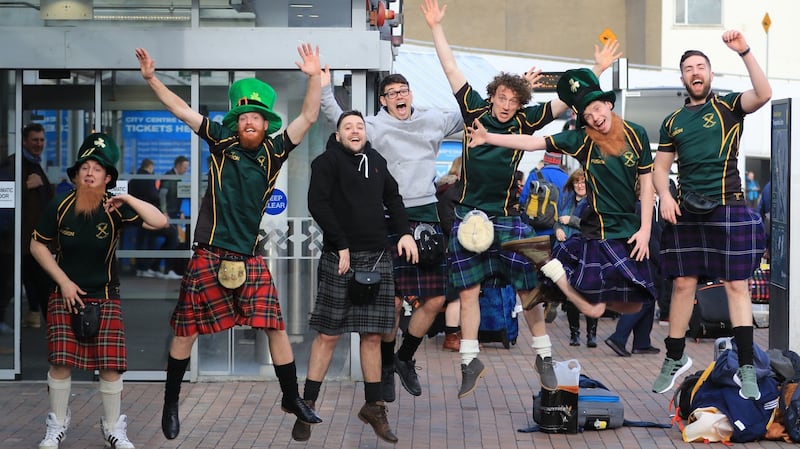
They always come to Dublin for birthdays and celebrations and, because they fly from different airports, they always meet at the same table of the airport’s Angel’s Share bar. Hughes has ordered prosecco. It’s her birthday today and her (first) gift is a green slanket bedecked with photos of her through the years.
For a few years running, Tina Cowey tells me, they dressed as “grannies” during their visits. Sam Oliphant shows me a photo of them with zimmer frames and wigs, crossing the road near Temple Bar.
“We literally stopped traffic,” says Cowey.
Why aren’t they dressed as grannies this time? “Now that we’re really grannies we don’t do that so much,” says Oliphant and they laugh.
Contraband
A piece of carved ivory, some stuffed baby alligators, a butcher's cleaver, a set of nunchucks, a large wooden hippo that has been used to smuggle drugs, an African mask that has been used to smuggle drugs, snake skin boots, a jar of scented herbs used to smuggle drugs, a truncheon, a bottle of whiskey containing a dead cobra and a dead scorpion, some tasers, a copy of A Series of Unfortunate Events by Lemony Snicket which has had a hole cut out of its pages to store cocaine, two metal knuckle-dusters, a replica Luger, some bird's nests and an illegal police scanner.
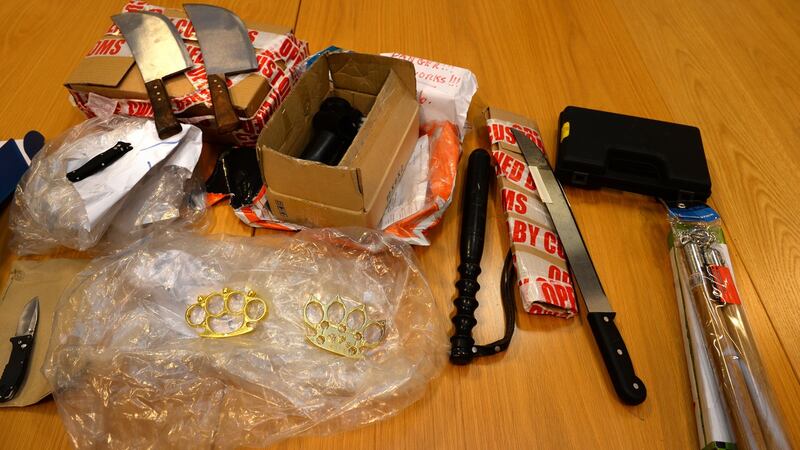
This is all laid out in an airside meeting room. “It’s like the ‘Generation Game’,” says a customs official named Fran.
These contraband items have been brought here by drug liaison officer Pat Lyons for my benefit. He shows me how the hollowed-out containers and toys are used for smuggling.
“One of the best ones I came across was a scented candle,” he says. “They’d cut a hole in the bottom of it and dug out as much of it as possible and then put their drugs inside it. The first glance on X-ray seemed fine but when you zoomed in you could see something was missing.”
He opens a brown leather briefcase filled with drugs. He shows me the drug khat, which is popular in some African countries, some “very pure” cocaine, some heroin, ecstasy, cannabis and some tabs of LSD.
“If you’re looking for a good party, talk to Pat,” says Fran.
“I’d like to say that I don’t take this home with me,” says Pat.

Almost daily, says Fran, they find someone bringing contraband into the country. Just that morning they found six kilograms of cannabis. They catch people based on sophisticated profiling, tip-offs, information from other agencies and simple intuition.
“The ones you have sympathy for,” he says, “are the kids coming from South America for an overnight who are paid 100 quid and are doing it for need rather than greed.”
There is around one “internal concealment” case a month, he says, where the smuggler has ingested the drug. What do customs do then? “You don’t want to know,” says Fran, but then he takes me to see “an office with an en suite”.

This is an interview room with a second room to the side. In this room there is an elevated toilet behind a glass wall. Beneath it there is a hatch which can be pulled out when the customs official need to see the contents.
I start pulling at the handle. “I wouldn’t touch that if I were you,” says Fran.
Sniffer dogs
Many of their finds are thanks to the dogs, says Fran. We walk through a dizzying number of doors (“It’s like Maxwell Smart around here”) and soon we’re looking at Scooby, a black Labrador, and Josie, a little brown and white spaniel, running around a baggage carousel. Scooby, Josie and their handlers constitute two of Dublin Airport’s eight dog teams.
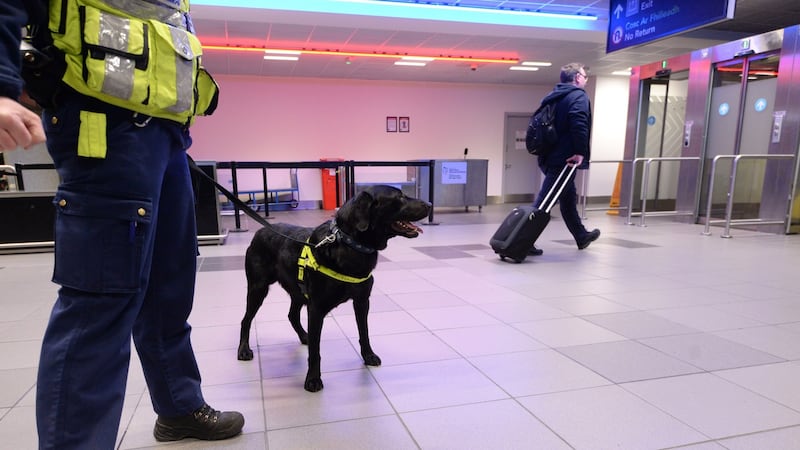
Scooby is so named, says his handler Nicola, “because he’s a bit of a wally but great at his job”. He’s a drugs dog, trained by an organisation called Wagtail in Wales. He lives at home with Nicola and can’t wait to come to work every day. As we’re talking a passenger starts rubbing Scooby behind the ears, which isn’t something Nicola usually encourages. “Except with kids,” she adds.
Josie, who is handled by John, is trained to detect laundered cash and, under secondment to the Department of Agriculture, food. At one point she stops at a big case and puts her paws over the top of it and remains totally still.
Scooby and Josie believe they’re looking for a tennis ball, which they associate with the smell they’re trained to seek, and when they find something, the handler gives them a ball from a pouch on his or her belt. “If they haven’t found anything in a while,” says Nicola, “we arrange for them to find something [to keep them motivated].”
For the whole time we’re with them, Scooby repeatedly returns to smell Fran’s shoes and trousers. “Was Pat showing you the drugs?” Nicola asks.
“Yes,” he says.
She laughs. “That’s probably why.”
Greetings
Four taxi drivers are waiting in arrivals holding cardboard signs. These are not the drivers who pay a fee to work from what is colloquially called “The Kesh”, the holding area from which the airport fills its taxi ranks. These drivers are affiliated with internet companies. “The price we have to pay for parking is ridiculous,” says Alan Mangan.
His friend Richie Walsh is distracted by an English stag party in leprechaun costumes. “Why do they wear the big green hats?” he asks. “You’d never see an Irish person going off to England in a union jack hat.”
“You certainly would not,” agrees Alan.
Nearby, a little girl called Orla sees her father and starts calling, “Daddy, Daddy, Daddy”. She’s been practising saying, “How was your flight Daddy?” her mother, Róisín Ni Chearbhaill, tells me. Eanna the baby is asleep in a pram.
Orla and Eanna’s father, Michael Mooney, has been away on business in Washington, Fort Lauderdale, Miami, Vegas, LA, San Diego, LA, Seoul, Hong Kong, Istanbul and Dublin. The past four days were spent entirely in meeting rooms and airports. “But he’s getting no sympathy from me,” says Ni Chearbhaill, who’s been at home with the kids.
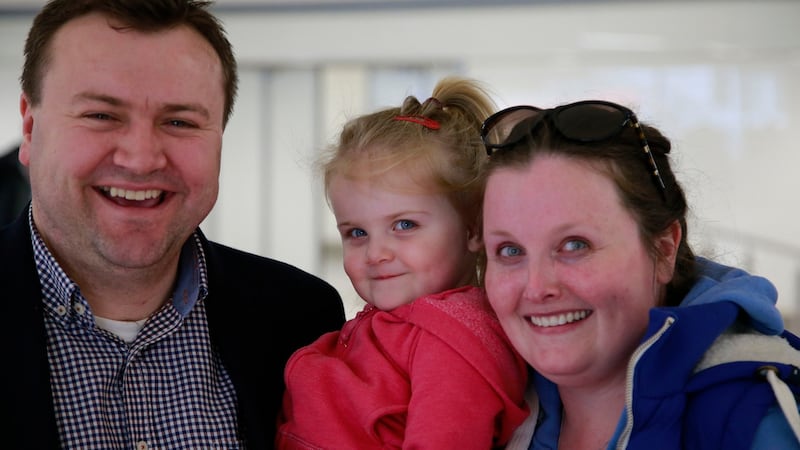
Traffic control
Paul McCann, operations manager at Dublin Airport’s air traffic control tower, talks about the 1,200 planes flying over Irish airspace every day in great eastward and westward waves. There are 100 air traffic controllers in Dublin with 15 working at a time, each managing 40 or 50 planes in a 70-mile radius. “Their basic job is to look out a window,” says McCann.
Nowadays technology augments their senses. In the radar room he shows me all the planes in the sky represented as blips on a screen. Up in the tower four controllers are quietly regarding their screens and the runway. They use binoculars from time to time and there’s a red emergency phone for contacting the fire station.
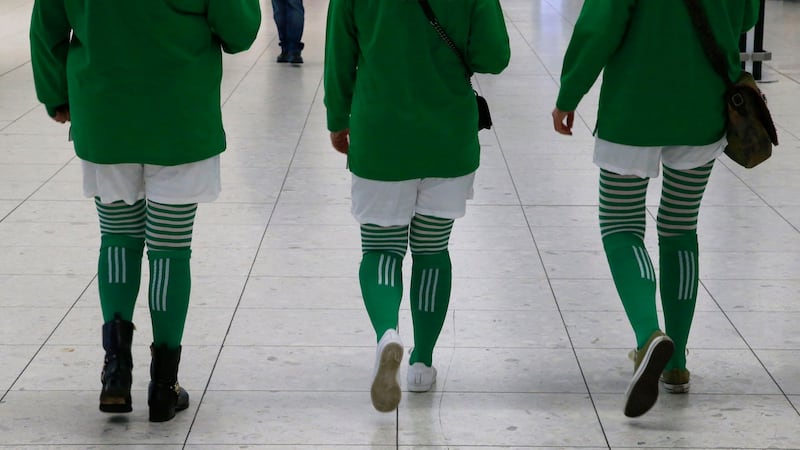
“We had an aircraft yesterday they couldn’t retract their landing gear. The whole airport then acts as one community.”
They also have a fancy coffee machine which, I suspect, is also an important bit of contemporary air traffic control technology and a box featuring anti-laser glasses. In other countries, McCann explains, kids with laser lights have tried blinding air traffic controllers in the past.
Downstairs there are “quiet rooms” where controllers can sit and relax. There are kitchen facilities and a gym. The corridors are filled with motivational posters of surfers and butterflies encouraging “confidence” and “change”.
The hallmark of a good air traffic controller, he says, is a sense of calm. “A lot of people would visit expecting chaos but it’s actually very quiet.”
Travelling musicians
In the departures area of Terminal 1, the singer songwriter Mundy is chatting to Danny O’Reilly from the band The Coronas. “We meet largely in airports now,” says Mundy.
O’Reilly and his band are going to Oslo then Sydney. Mundy is playing in Belgrade, Singapore, Hong Kong and Tokyo. “A lot of my generation emigrated, and there are audiences for me in those places,” he says.
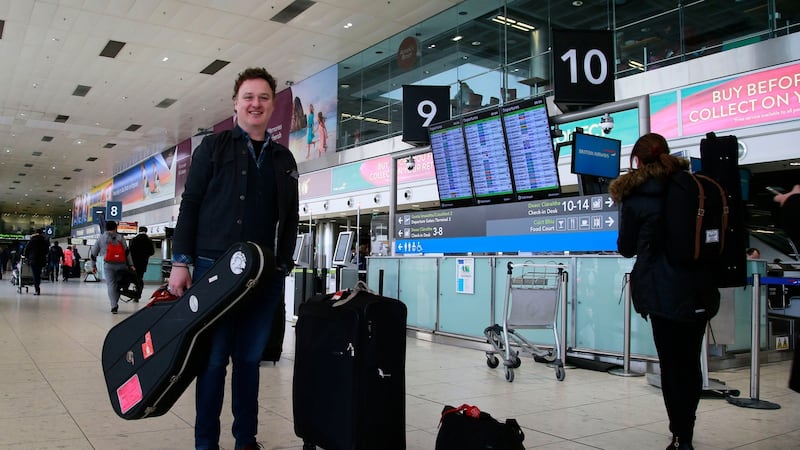
He’s travelling with a guitar and a huge suitcase filled with merchandise, musical equipment and three different kinds of plug. Does he have advice for less-seasoned travellers? “Don’t eat scrambled eggs in airports. Don’t wear a belt. Wear flip flops and tracksuit bottoms.” (He’s not wearing flip flops and tracksuit bottoms.)
How does he find touring alone? “Two weeks is fine,” he says. “But on the sixth week of a six-week-tour you can feel quite brittle.”
Nearby, Ting Ting Lin, her husband Brian Farrelly and their little son Conn are saying goodbye to Brian’s father, John Joe. Farrelly met Lin while working for Intel in China to which they are now returning for six months.
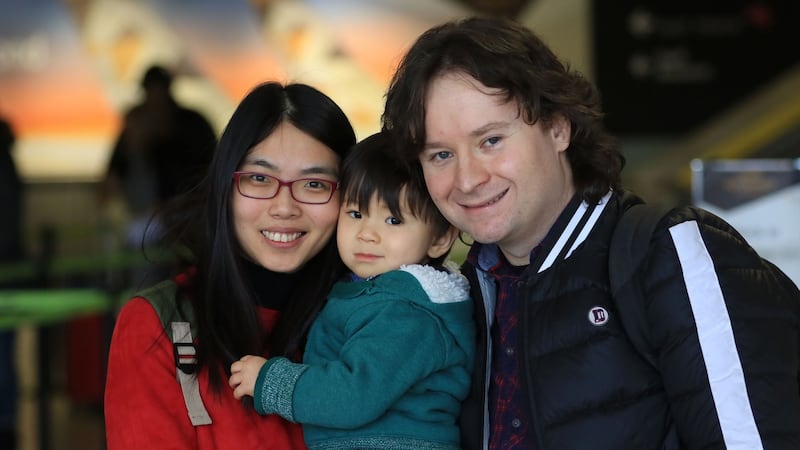
They’ve been in Farrelly’s home town of Oldcastle, Co Meath, for the past two years. That took some adjustment for Lin. Dalian is a city of 6 million people, she says, “and Meath is cows and grass”.
When Lin arrived in Ireland, John Joe said, “We’ve got to get this girl driving,” and he helped teach her to drive. She calls him “Dad” at one point during our encounter. John Joe’s wife died in recent years and he says he’s going to miss them all terribly, “particularly the little lad. If they’re not back then I’ll be . . .” He can’t find the word.
“Heartbroken,” says Lin.
Lost and found
The airport police at Dublin Airport look after the biggest lost-and-found office in the country. They have teddy bears, glasses, jewellery, belts, kindles, laptops, driving licences, passports, fully packed suitcases, watches, walking sticks, wheelchairs, crutches.
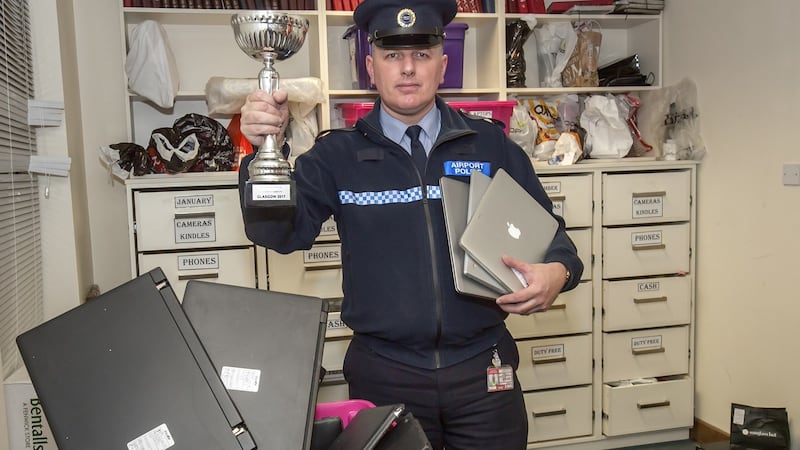
“Miracles take place at Dublin Airport every day, apparently,” says Siobhán O’Donnell.
“We found an X-Ray of someone’s chest once,” says airport policeman Brendan Lavin.
“We’ve had a headstone,” says O’Donnell. “And an urn of ashes.”
What else would the airport police find themselves involved with?
“We have a defibrillator programme in the airport,” says Lavin
“In 15 years we’ve saved 27 lives,” says O’Donnell. “There was a baby born here a few years ago.”
And there’s crime, of course. “People are fraught, distressed and stress levels rise,” says Lavin. “And we see a lot of mental health issues too. Some people are drawn here. They mightn’t have any reason at all to be here but still they come.”
At lunchtime I notice an older man in Arrivals holding a bunch of flowers and a welcome sign. I saw him at 7am, and he is still here. Recalling what Brendan Lavin tells me about people coming to the airport for no reason, I try talking to him. He points to a hearing aid and shakes his head.
The terminal seems quite busy now. Tony Dolan, a middle-aged kitchen fitter who travels regularly to the UK to see a sick aunt, recalls when air travel was rare. “People fly to places I’ve never heard of now,” he says.
I bump into an old friend who is collecting an American friar. A man rushes by carrying a French bulldog in a dog carrier to whom he is muttering angrily. Our photographer photographs some kilt-wearing Scottish men who decide to lift their kilts.
“There are some things you just can’t unsee,” he says, before showing me the photograph.
“Why?” I ask.
“I didn’t want to suffer alone.”
Plane spotters
At the Old Airport Road along the airport’s green boundary fence, Esther Rowley offers to move her wheelchair so I can sit into the passenger seat of her white Polo. This is one of two lay-bys frequented by plane spotters on the edges of the airport.
“I used to be brought here as a kid,” she says and she sighs. “I was just fascinated that they could fly . . . It’s my happy place.”
Rowley is one of the many spotters who regularly come to watch and photograph unusual planes. She has an app called Flight Radar on her phone that looks like something they might have in air traffic control and there’s a Facebook group of about 5,000 people who share tips. “When I was younger, I’d come here with my mam and we’d just look up Aertel before coming to see what we might get.”
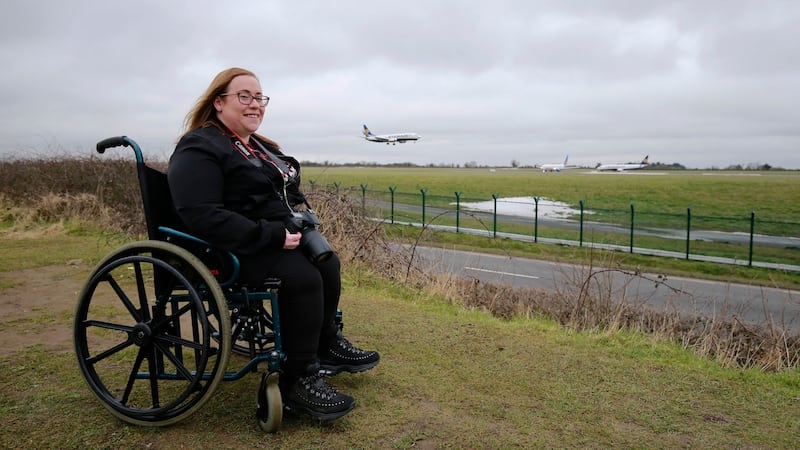
She has many spotter friends and she often flies to other airports – Birmingham, Manchester and Amsterdam – just to watch planes.
Rowley formerly worked in the travel industry, and then she worked with Ryanair for a while. Now she has a job that has nothing to do with aviation and she thinks that might be for the best. "It's great to see how the airport has changed and grown. Once there'd be a lull in the flights. Nowadays there's no lull. We can't wait for the new runway."
Sometimes she comes out because a rare plane is expected but sometimes she comes with no agenda whatsoever. She makes it sound relaxing, like watching the sea coming in and out.
What's her favourite plane? "The Aer Lingus A330. I'm known for my love of that plane. Every time I see it, it feels like the first time."
She points at a taxiing plane. “There’s an Etiad A330. But that’s not the same. It needs to be the Aer Lingus one.”
Why?
“Because of the colour. Because it’s home.”
In numbers
1940 Year Dublin Airport opened
80,000 Average daily passengers
3,000 Trolleys
1,200 Planes flying over Irish airspace every day
190 Destinations flown to, in more than 40 countries
19,700 Jobs at Dublin Airport and airport-related businesses
85 Air traffic controllers
<3 Emergency response time is below three minutes
5,00 Size of the plane spotters' Facebook group
18,600 Parking spaces (15,500 long-term; 3,100 short-term)


























